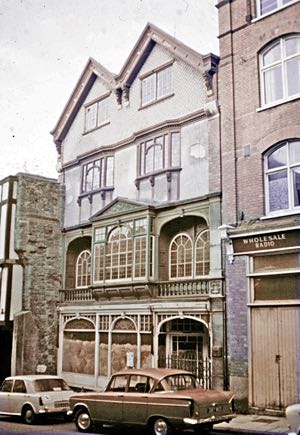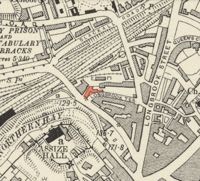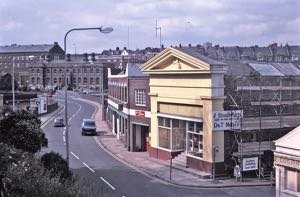
Exeter's Minor Breweries
Page added 5th February 2015
Return to Industrial Exeter
Eagle Brewery
There was an earlier Eagle Brewery initially based in Sidwell Street, in 1850. It supplied ingredients for home brewing. Run by Frederick Pinder, he went into partnership with Henry Hull and relocated to 25 North Street in 1851, and started to brew "genuine home-brewed ALES AND PORTER".
In February 1872, Pinder sold the business to J J Wilkinson. In 1875, Wilkinson applied for the license to run the Three Cranes in South Street, and a few days later, sold the brewery to George and Charles Finch. The new owners, for 16 years, had operated a Wine and Spirit and Hop merchants at 144 Fore Street. The premises in North Street were sold from the estate of the late Frederick Pinder in May 1876, to the Finch's for £1910. The brothers had to publish an apology for using casks belonging to Samuel Allsopp, brewers of Burton-on-Trent.
John Parnell Tucker of Ashburton supplied the brewery with its malt, having met the partners at the Lower Market's corn exchange. The company purchased the Cowley Bridge Inn during 1879, one of 15 public houses owned by the brewery.
The brewery had a yard at the rear that was used for stabling, and occupied by Mr Finch and Mr Letheren, harness maker. In July 1894 a fire broke out in the yard, which contained a large quantity of hay. The Fire Brigade arrived, and three horses were saved. The fire was extinguished within 15 minutes, despite flames rising high into the sky. The surrounding cottages were also saved.
The Finch Eagle Brewery was purchased on 19 November 1892 by the Heavitree Brewery, for £20,000, and closed down.
 The Eagle Brewery was located in this building, next to the Elephant Inn, left. It was renumbered 38 North Street.
The Eagle Brewery was located in this building, next to the Elephant Inn, left. It was renumbered 38 North Street. Newspaper
advert for the Eagle 1854.
Newspaper
advert for the Eagle 1854.Northernhay Brewery
 Historically, the Northernhay Brewery was a late
starter in the city and open for a relatively short time, although the building was used as a brewery store after brewing ceased. The premises originally opened as the Devon and
Exeter Foundry, run by Charles Coldridge & Sons, in 1840, just
after New North Road had been cut, opening up this part of the city. The business was put up for
sale in 1843, as a foundry
Historically, the Northernhay Brewery was a late
starter in the city and open for a relatively short time, although the building was used as a brewery store after brewing ceased. The premises originally opened as the Devon and
Exeter Foundry, run by Charles Coldridge & Sons, in 1840, just
after New North Road had been cut, opening up this part of the city. The business was put up for
sale in 1843, as a foundry
The premises were taken over, and opened as the Northernhay Brewery, run by John Hyett. Hyett's three sons were prosecuted in June 1847 for stealing a package from the Post Office containing sixty, five pound notes. How this case affected their father is not known, but the following month, John Hyett committed suicide by taking cyanide. Mrs M Hyett continued to run the business, with two of her sons, Edwin and Henry.
The brewery appears to have closed around about 1858, and the handsome building was used as a music hall for a short time. In 1861, the property was up for sale, in the occupation of a corn merchant. The particulars for the sale indicated that the brewing equipment was still in situ. By 1869, the Bristol brewery of Charles Garton Russell and Co., were installed in the building as a brewery store – the coming of the railway to Queen Street gave them the use of sidings for transporting their products. Russell and Co., were responsible for placing the 3ft long cast-iron sphinx statue on the pediment of the building with the trademark 'Puritas Viresque' (pure and strong) cast along its base.The store supplied locally via horse and cart or further afield to Okehampton, Barnstaple, Ottery St Mary, Seaton and Torbay by rail. In 1900, the Anglo Bavarian Brewery took over the premises – however, their tenure was short lived and the premises were converted for a tent, marquee and tarpaulin manufacturing. The building was demolished in November 1991 and Longbrook House constructed to house the local Inland Revenue.
 The site of the brewery and store is the cream building.
The site of the brewery and store is the cream building. The Sphinx was located at the apex of the classical frontage.
The Sphinx was located at the apex of the classical frontage.West of England Brewery
Between 1851 and 1889, William Lindsey Mortimore, who was descended from a Bradninch family, is listed as innkeeper of the Okehampton Inn, Okehampton Street. His will of 1887 refers to his ownership of a newly erected brewery and malthouse opposite the Okehampton Inn. Mortimore owned in total five inns including the Okehampton Inn, the Golden Ball in Mary Arches Street, the Anchor in Paul Street, the Duke of York in Coombe Street and the Dolphin Inn in Market Street. The inns were run by tenants and left to his children at his death. Situated in Okehampton Street, the brewery building is clearly shown on the 1876 OS map.
His son, also a William, at the death of his father in 1890, took over the brewery, now known as Mortimore's along with the Okehampton Inn. He sold the business in 1906 to William Henry Morton, the tenant of the Turk's Head in the High Street. Carr and Quick Ltd of Exeter acquired the brewery in 1909 at an auction at the Half Moon Inn. Brewing ceased in 1926.
Stevenson & Son
The present Sorry Head (formerly Horse and Dray) in Blackboy Road was once a brewery when the public house was named the George & Dragon, owned by Stevenson & Son. Brewing ceased in 1921.
Brice & Burgoyne
Situated in the Ship, Heavitree (now the Ship and Pelican), this brewery existed circa 1885.
Sources - The Land of Bill Brewer, Express & Echo, Financial Times, Morning Advertiser, Trewman's Exeter Flying Post, Izacke, the Exe Island and the City Brewery by Pring, Jenkins and Hoker histories, Heavitree by Hazel Harvey, Ordnance Survey map 1876, Carl Mortimer and lastly, Steve Coombes.
│ Top of Page │